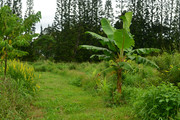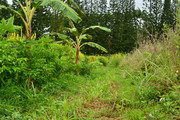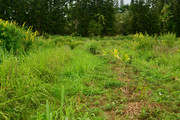youre absolutely right. and i do have my moringas and comfreys (dont grow so well without chicken poop because of the infertility at this point) but i gotta work with what grows here. tree farming is all about maintenance and good design

. i do not allow the guinea to be in my tree cropping rows and just in my mow rows. would i rather be mowing weekly around each individual tree like most people here do? having a lawn with my 'orchard' of trees at some sort of strange distance from another. then bring in inputs to mulch and fert my trees? nope im trying to grow biomass to feed the soil everywhere to grow a forest. i can mow my entire 3.5 acre plots in 5 hours. doing that once a month isnt such a big deal. especially if i space it out. raking and mulching takes a little longer. thats why im trying to grow my biomass in place so i dont have to haul my mulch.

this was my original system. mowing the wainaku grass. ive now decided to plant guinea in the mow zone to create more biomass to feed my cropping row. coconuts and bananas with edible hibiscus, cassava, sugarcane, coleus, squash, blue basil, bush basil, Plectranthus barbatus and cosmos. the entire row besides the coconuts are used for mulch. add on the guinea in the mow row and i can add 2' of mulch per month to each coconut. now were talking. the border row is full of crotalaria, gliricidia, inga and a few trema. only the trema are large enough to harvest biomass. but the future looks strong for the trees. the cropping row was planted in november
got the guinea in last week. update will be reported

these photos are younger zones but already planted the guinea in them. just came through last week and cut down all the sunn hemp, cosmos and some of the crotalaria. the trees have been in the system 2 months. replanted with mexican sunflower cassava and a few other vigorous cuttings. we shall watch the progress unfold



 . i do not allow the guinea to be in my tree cropping rows and just in my mow rows. would i rather be mowing weekly around each individual tree like most people here do? having a lawn with my 'orchard' of trees at some sort of strange distance from another. then bring in inputs to mulch and fert my trees? nope im trying to grow biomass to feed the soil everywhere to grow a forest. i can mow my entire 3.5 acre plots in 5 hours. doing that once a month isnt such a big deal. especially if i space it out. raking and mulching takes a little longer. thats why im trying to grow my biomass in place so i dont have to haul my mulch.
. i do not allow the guinea to be in my tree cropping rows and just in my mow rows. would i rather be mowing weekly around each individual tree like most people here do? having a lawn with my 'orchard' of trees at some sort of strange distance from another. then bring in inputs to mulch and fert my trees? nope im trying to grow biomass to feed the soil everywhere to grow a forest. i can mow my entire 3.5 acre plots in 5 hours. doing that once a month isnt such a big deal. especially if i space it out. raking and mulching takes a little longer. thats why im trying to grow my biomass in place so i dont have to haul my mulch. 




